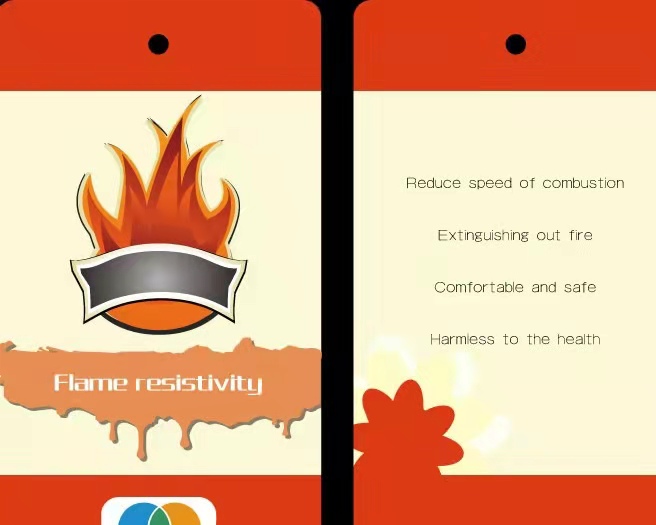
Flame Retardant CP for Cotton Fabric
Pure cotton flame retardant finishing agent CP is a durable reactive flame retardant. It undergoes polymerization or condensation reaction on the inner surface of cellulose fibers to form a water-insoluble polymer. It is suitable for pure cotton woven fabrics, knitted fabrics, towels, and beds. Durable flame-retardant finishing of upholstery, bed sheets, canvas, home textile products, curtains, tablecloths, carpets, tents, wall coverings, sofa covers and other decorative fabrics. In addition, it is also suitable for durable flame-retardant fabrics such as linen and viscose. sort out.
The main component of pure cotton flame retardant finishing agent CP is a nitrogen-containing organic phosphate compound, and the appearance is a light yellow transparent solution, the effective ingredient content is greater than 80%, the phosphorus content: ≥12%, PH value: 6+1, boiling point: 420°C (at 760 mmHg), non-dangerous goods, good compatibility with various finishing auxiliaries. The flame retardant CP is simple to use, can be processed on conventional printing and dyeing equipment, and has good physical compatibility with various finishing auxiliaries.
JLSUN®CP environmentally friendly flame-retardant cotton fabric has no continuous burning and smoldering phenomenon, and meets the requirements of GB 18401-2010 for textiles that directly contact the skin. The flame retardant performance can pass Chinese standards GB 8965 and GB 5455; American standards CA117 (furniture sofa) , TB603 (mattresses), FMVSS302 (car upholstery fabrics), NFPA701, NFPA261-94, CS191-51, CPAI-84 (tents), CFR1610 (clothing), CFR1633; European standards EN 531, EN 532, EN 533, EN 470, EN 469, EN-71 (toys); Australia AS 4824 and British standards BS 5852 (furniture and sofa), BS7176 (cushion seat), BS7177 (mattress), EN-71 (toys) ) And FAR 25.853, CAN/ULC-S109. After washing 50 times of JLSUN®CP environmentally friendly flame-retardant fabrics, the flame-retardant effect can still reach above B2 level in GB5455-85, the flame-retardant products have little strength reduction, good hand feeling, formaldehyde content less than 75ppm, and no APEO, heavy metals and aromatic amines. , And does not contain REACH restricted substances (SVHC) and the following non-environmentally friendly compounds (Tris(2-chloroethyl) phosphate (TCEP), Tris(1,3-dicloro-2-propyl) phosphate (TDCPP), Tris(2,3- dibromopropyl)phosphate (TDBPP).
Structural components: dimethyl 3-[(hydroxymethyl)amino]-3-oxopropylphosphonate
(3-(dimethylphosphono)-n-methylolpropionamide)
CAS No.: 20120-33-6
Structural formula: O O
‖ ‖
(C2H5O2) 2P—CH2 CH2 C NHCH2OH
Instructions for use
1. Process formula:
Dosage (g/l)
Pure cotton flame retardant finishing agent CP 300-450
Six hydroxyl resin 6MD (48%) 60-100
Phosphoric acid (85%) 18-20
Recommended process
Working solution preparation instructions:
(1) First, add an appropriate amount of water into the chemical tank, and then add the pure cotton flame-retardant finishing agent CP, resin and phosphoric acid in the order of the formula (dilute with water before use).
(2) When selecting softener, hydrophilic softener SCG should be used to avoid the influence on flame retardant performance.
2. Process flow:
The cotton fabric after bleaching and drying → padding (two soaking and two padding, the padding rate is 75-80%) → drying (100-105°C) → baking (160°C, 4-5min) → alkaline washing (sodium carbonate) 5g/L, 20-40°C) → soaping (deodorizing soap lotion FB-28C, 6-8g/l, 60±2°C×3 minutes) → three compartments of hot water washing (countercurrent) → one compartment of cold water Wash → dry.
Points to note:
1. The fabric before flame-retardant finishing should have good water absorption, the wool effect should be above 8cm, the impurity removal should be clean, and the fabric surface should be neutral or slightly acidic (PH value 5-7).
2. The amount of flame retardant depends on the type of fabric, and the user is required to conduct experiments to determine the specific amount. Generally, the amount of heavy fabrics is small, and the amount of thin fabrics should be increased appropriately.
3. In order to increase the strength, an appropriate amount of fiber protective agent can also be added to the formula.
4. If the permeability of the fabric is poor, an appropriate amount of non-ionic penetrant can be added to the prescription.
Packaging and storage: 60 kg plastic drum. Stored in a cool warehouse, the storage stability period is one year.
